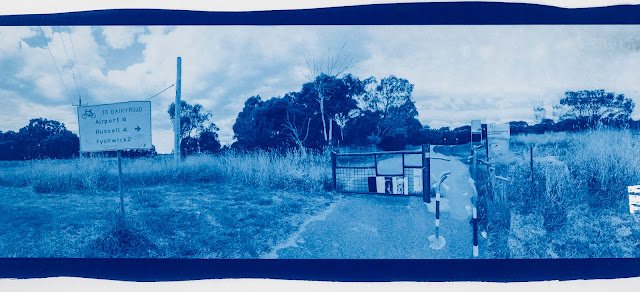Photography Exhibition Review | Brian Rope
ACT Hub, 14 Spinifex
Street, Kingston | Until 25 June 2022
(By appointment or
during theatre performances)
The Causeway Hall in Kingston is the oldest hall in Canberra and a listed item on the ACT Heritage Register. It was completed in 1926 with voluntary labour using materials provided by the Federal Capital Commission. The Causeway remains a distinct district within the suburb of Kingston, although now abutted by the foreshore development.
For some time, the Hall served as Canberra's principal
place of entertainment. It was, variously, a picture theatre, a dance hall, a
concert venue and a place where boxing matches were held.
This year has seen the building transformed and, as ACT HUB, become a venue for independent theatre productions, such as Free Rain’s production of David Williamson’s Emerald City (8 – 25 June). It is also now presenting exhibitions of artworks, with this show by Jane Duong being the first.
Sunkissed is a modest exhibition. Modest in terms of artwork numbers
and sizes. Modest in terms of the works being gentle, almost describable as
quiet. They do not shout out for attention, but nevertheless encourage visitors
in for a closer investigation of their contents. The venue itself is also
modest – in terms of capacity and its somewhat understated décor in the
particular area where the artworks hang.
Duong is a Canberra-based photographer with a Bachelor of Communications, majoring in photomedia, and a Diploma in Museums and Collections. Her previous photographic projects include Red Brick Road images from another important part of Canberra’s heritage - the Yarralumla Brickworks.
Red Brick Road was
an exploration of the Brickworks architecture, landscape and objects and the
use of photography to trigger, layer and construct memory. Duong’s works for
that show combined film photography with Van Dyke Brown printing, allowing for
the study and representation of time and the ephemeral nature of memory.
The heritage listing of the Causeway Hall makes it most appropriate that Duong has again used an old technique to explore and celebrate it and the nearby Jerrabomberra Wetlands. This time, however, the process is Cyanotype which dates back to the dawn of photography and was invented by astronomer Sir John Herschel in 1842. Cyanotype prints are created with the use of a light-sensitive chemical mixture coated on paper, UV (or sun) light and water to develop and fix.
For heritage reasons, it is not possible to attach works
directly to the walls as is a common practice today in many galleries. So all
the works are framed. They look great hanging - from a “picture rail” - against
a wall, the colour of which blends nicely with the frames and shows off the
classic blue tones of cyanotypes.
Each one-off print in this exhibition has been handmade by Duong. Some have unique borders, some have been created with a negative contact sheet, while others have been dipped directly into Wetland waterways.
Several of the works show the Hall itself. Duong has
created panoramas using her phone, distorting the building a little, and used
software to make some adjustments. Then she has used an inkjet printer to
create negatives of each finished image on A4-sized film and used those
negatives to create her exhibited prints on cotton paper using the Cyanotype
process.
 |
Old Causeway Hall II_Jane Duong_2022 |
Other works show a nearby entrance to, and parts of, the
Jerrabomberra Wetlands – which themselves include some important historic
relics of early Canberra.

Jerra Wetlands_Jane Duong_2022
 |
Biyaligee Boardwalk_Jane Duong_2022 |
 |
Waterways_Jane Duong_2022 |
And then there are two very different works. These were made by placing the paper directly into Wetlands waterways. They are dark and moody images, which seem quite an appropriate way to show an underwater area. The resultant works allow viewers to consider for themselves just what they are seeing.